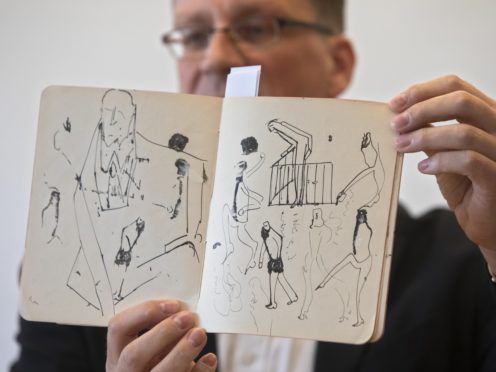
Israel’s National Library has unveiled a batch of previously unseen personal letters, illustrations, diaries and handwritten manuscripts belonging to famed author Franz Kafka.
After a lengthy legal saga, the papers arrived from a Swiss bank two weeks ago with roughly 100 other artifacts.
The released materials are the final unseen portion of a collection inherited by Max Brod, Kafka’s long-time friend and editor, and the publication marks the end of an 11-year battle in court.
Although the collection does not include substantial unpublished work by Kafka, researchers believe it will help shed light on the life and thinking of one of the most influential writers of the 20th century.
Newly arrived at the @NLIsrael: Rare #Kafka manuscripts, including drafts of the uncompleted story “Wedding Preparations in the Country”, a notebook for learning Hebrew, hundreds of personal letters, sketches, and morehttps://t.co/vlzZ9HRWun
— National Library of Israel (@NLIsrael) August 7, 2019
“We are very happy for this moment, finally, after almost 12 years of legal proceedings, many travels and treasure hunts, to bring Max Brod’s estate with papers of Franz Kafka to Jerusalem,” said Oren Weinberg, the director of Israel’s National Library.
He said the release fulfilled Brod’s wishes to make the materials publicly accessible and enhances research on the influential author.
Kafka, a German-speaking Jew from Prague, was a little-known writer when he died of tuberculosis in 1924 at the age of 40. Shortly before his death, he bequeathed his writings to Brod, instructing him to burn it all unread.
Brod instead published most of the writings in his possession, turning Kafka posthumously into a literary sensation. Kafka, best known for his works The Metamorphosis, The Trial and The Castle, is famous for pinning everyday protagonists against absurd and mysterious situations and authorities.

Brod smuggled some of Kafka’s works to pre-state Israel when he fled the Nazis in 1938 and passed some of his collection to Israeli public archives. The rest of his archive was inherited by his secretary, Esther Hoffe. Brod requested that she pass on the remaining works to an academic institution.
Instead, for the following four decades she kept the collection in her cat-filled apartment in Tel Aviv, and in banks in Switzerland and Israel. She also sold some of the items for hefty sums.
When she died in 2008 at the age of 101, the cache was passed to her two daughters who considered Brod a father figure and his archive their rightful inheritance.
The hearing in a court for family matters in Tel Aviv over the inheritance caught the attention of Meir Heller, the legal counsel for Israel’s National Library, and set in motion a legal battle over the collection.
Mr Heller said he argued that Brod had requested that the collection be passed on to the National Library, and that Kafka’s writings are a “cultural asset” to Israel. The legal fight eventually reached Israel’s Supreme Court, which sided with the library.
Most of the artifacts displayed on Wednesday were held in a bank in Zurich and are believed to be the last unseen batch of Brod’s collection.
Previous portions of the archive were retrieved from German police, who confiscated works that were believed to have been smuggled, a Tel Aviv apartment and from Israeli bank vaults. Swiss courts reviewed and agreed with the Israeli verdict before materials were handed over.
David Blumberg, chairman of the board of directors at the National Library, said the library will digitise the collection and make it available for a global audience.

Enjoy the convenience of having The Sunday Post delivered as a digital ePaper straight to your smartphone, tablet or computer.
Subscribe for only £5.49 a month and enjoy all the benefits of the printed paper as a digital replica.
Subscribe